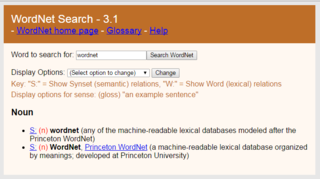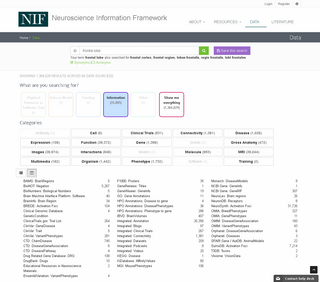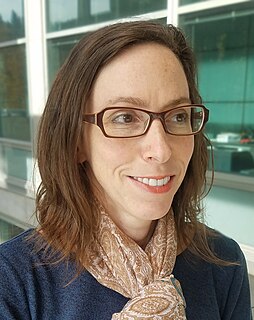The Semantic Web, sometimes known as Web 3.0, is an extension of the World Wide Web through standards set by the World Wide Web Consortium (W3C). The goal of the Semantic Web is to make Internet data machine-readable.

WordNet is a lexical database of semantic relations between words in more than 200 languages. WordNet links words into semantic relations including synonyms, hyponyms, and meronyms. The synonyms are grouped into synsets with short definitions and usage examples. WordNet can thus be seen as a combination and extension of a dictionary and thesaurus. While it is accessible to human users via a web browser, its primary use is in automatic text analysis and artificial intelligence applications. WordNet was first created in the English language and the English WordNet database and software tools have been released under a BSD style license and are freely available for download from that WordNet website.
In computer science and information science, an ontology encompasses a representation, formal naming, and definition of the categories, properties, and relations between the concepts, data, and entities that substantiate one, many, or all domains of discourse. More simply, an ontology is a way of showing the properties of a subject area and how they are related, by defining a set of concepts and categories that represent the subject.
The Gene Ontology (GO) is a major bioinformatics initiative to unify the representation of gene and gene product attributes across all species. More specifically, the project aims to: 1) maintain and develop its controlled vocabulary of gene and gene product attributes; 2) annotate genes and gene products, and assimilate and disseminate annotation data; and 3) provide tools for easy access to all aspects of the data provided by the project, and to enable functional interpretation of experimental data using the GO, for example via enrichment analysis. GO is part of a larger classification effort, the Open Biomedical Ontologies, being one of the Initial Candidate Members of the OBO Foundry.
BRENDA is an information system representing one of the most comprehensive enzyme repositories. It is an electronic resource that comprises molecular and biochemical information on enzymes that have been classified by the IUBMB. Every classified enzyme is characterized with respect to its catalyzed biochemical reaction. Kinetic properties of the corresponding reactants are described in detail. BRENDA contains enzyme-specific data manually extracted from primary scientific literature and additional data derived from automatic information retrieval methods such as text mining. It provides a web-based user interface that allows a convenient and sophisticated access to the data.

The Rat Genome Database (RGD) is a database of rat genomics, genetics, physiology and functional data, as well as data for comparative genomics between rat, human and mouse. RGD is responsible for attaching biological information to the rat genome via structured vocabulary, or ontology, annotations assigned to genes and quantitative trait loci (QTL), and for consolidating rat strain data and making it available to the research community. They are also developing a suite of tools for mining and analyzing genomic, physiologic and functional data for the rat, and comparative data for rat, mouse, human, and five other species.
Ontology alignment, or ontology matching, is the process of determining correspondences between concepts in ontologies. A set of correspondences is also called an alignment. The phrase takes on a slightly different meaning, in computer science, cognitive science or philosophy.
The Open Biological and Biomedical Ontologies (OBO) Foundry is a group of people dedicated to build and maintain ontologies related to the life sciences. The OBO Foundry establishes a set of principles for ontology development for creating a suite of interoperable reference ontologies in the biomedical domain. Currently, there are more than a hundred ontologies that follow the OBO Foundry principles.
Linguistic categories include

The Neuroscience Information Framework is a repository of global neuroscience web resources, including experimental, clinical, and translational neuroscience databases, knowledge bases, atlases, and genetic/genomic resources and provides many authoritative links throughout the neuroscience portal of Wikipedia.
Metadatabase is a database model for (1) metadata management, (2) global query of independent databases, and (3) distributed data processing. The word metadatabase is an addition to the dictionary. Originally, metadata was only a common term referring simply to "data about data", such as tags, keywords, and markup headers. However, in this technology, the concept of metadata is extended to also include such data and knowledge representation as information models, application logic, and analytic models. In the case of analytic models, it is also referred to as a Modelbase.
Knowledge extraction is the creation of knowledge from structured and unstructured sources. The resulting knowledge needs to be in a machine-readable and machine-interpretable format and must represent knowledge in a manner that facilitates inferencing. Although it is methodically similar to information extraction (NLP) and ETL, the main criterion is that the extraction result goes beyond the creation of structured information or the transformation into a relational schema. It requires either the reuse of existing formal knowledge or the generation of a schema based on the source data.
Suzanna (Suzi) E. Lewis was a scientist and Principal investigator at the Berkeley Bioinformatics Open-source Project based at Lawrence Berkeley National Laboratory until her retirement in 2019. Lewis led the development of open standards and software for genome annotation and ontologies.
The Uber-anatomy ontology (Uberon) is a comparative anatomy ontology representing a variety of structures found in animals, such as lungs, muscles, bones, feathers and fins. These structures are connected to other structures via relationships such as part-of and develops-from. One of the uses of this ontology is to integrate data from different biological databases, and other species-specific ontologies such as the Foundational Model of Anatomy.
SciCrunch is a collaboratively edited knowledge base about scientific resources. It is a community portal for researchers and a content management system for data and databases. It is intended to provide a common source of data to the research community and the data about Research Resource Identifiers (RRIDs), which can be used in scientific publications. In some respect, it is for science and scholarly publishing, similar to what Wikidata is for Wikimedia Foundation projects. Hosted by the University of California, San Diego, SciCrunch was also designed to help communities of researchers create their own portals to provide access to resources, databases and tools of relevance to their research areas
In natural language processing, linguistics, and neighboring fields, Linguistic Linked Open Data (LLOD) describes a method and an interdisciplinary community concerned with creating, sharing, and (re-)using language resources in accordance with Linked Data principles. The Linguistic Linked Open Data Cloud was conceived and is being maintained by the Open Linguistics Working Group (OWLG) of the Open Knowledge Foundation, but has been a point of focal activity for several W3C community groups, research projects, and infrastructure efforts since then.
The Monarch Initiative is a large scale bioinformatics web resource focused on leveraging existing biomedical knowledge to connect genotypes with phenotypes in an effort to aid research that combats genetic diseases. Monarch does this by integrating multi-species genotype, phenotype, genetic variant and disease knowledge from various existing biomedical data resources into a centralized and structured database. While this integration process has been traditionally done manually by basic researchers and clinicians on a case-by-case basis, The Monarch Initiative provides an aggregated and structured collection of data and tools that make biomedical knowledge exploration more efficient and effective.
In linguistics and language technology, a language resource is a "[composition] of linguistic material used in the construction, improvement and/or evaluation of language processing applications, (...) in language and language-mediated research studies and applications."

Melissa Anne Haendel is an American epidemiologist who is a Professor of Medical Informatics at the Oregon Health & Science University. She serves as Director of the Center for Data to Health (CD2H). Her research makes use of data to improve the discovery and diagnosis of diseases. During the COVID-19 pandemic, Haendel joined with the National Institutes of Health to launch the National COVID Cohort Collaborative (N3C), which looks to identify the risk factors that can predict severity of disease outcome and help to identify treatments.



